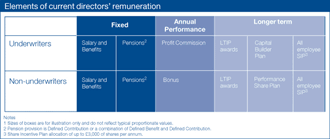Accountability
Directors’ remuneration report
Remuneration policies
Overall remuneration levels and factors specific to the non-life insurance underwriting sector
In determining individuals’ remuneration, the Group has regard to their performance in the role, job evaluation of the role and remuneration statistics for the non-life insurance sector in which the Group operates and, where applicable for certain roles, wider remuneration statistics. Across all categories of staff, including executive directors, the Group’s policy is to have regard to market or peer group median salaries for the role, with the potential for top quartile remuneration for top quartile performance. This policy aims to encourage and reward superior rather than merely average performance. Salaries are generally reviewed as at 1 April each year.
Remuneration for underwriters and those performing technical insurance-related roles is strongly influenced by the Lloyd’s sector in which the Group’s UK employees operate. Lloyd’s underwriting businesses tend to relate a significant proportion of the potential rewards of underwriters to the absolute profitability of the relevant underwriting unit. Historically such profit share schemes have operated on an uncapped basis in money terms although they are capped as a percentage of the relevant profit pool which in turn is capped by the overall regulatory capacity and/or capital of the syndicate and the Group. Amlin has followed this practice for staff for whom such market influenced remuneration structures are appropriate. Similar remuneration structures and policies have been adopted for staff in Amlin Bermuda Ltd, although in that case the uncapped element of underwriters’ remuneration is balanced by a capped bonus plan. Anglo French Underwriters (AFU) in Paris, the Group’s second business with any material number of non-UK staff, was acquired in November 2008 and its remuneration policies are currently being reviewed. They are not yet integrated with those of the Group and, other than where specifically mentioned, are not covered by this report. The review will seek to achieve an appropriate balance between local and Amlin Group practice. In all spheres of operation, the Committee aims to keep the market practices of its competitors for staff under review and believes that, as market and Amlin’s own practices evolve, it is always important to ensure that remuneration structures support the Group’s competitive advantage rather than undermine it.
Structure of directors’ and employees’ remuneration, and alignment of interests with shareholders
As summarised earlier, the remuneration of all executive directors and other senior employees consists of three principal elements: (1) base salary, benefits and pension contributions; (2) shorter term performance rewards (on an annual or underwriting year basis); and (3) longer term performance rewards (measured over three or five year performance periods). The specific components of each of these three elements are illustrated in the chart below.

Click here for full sized image
Excluding all long term incentive plans, in 2008 an estimated average of 65% (2007: 64%) of total executive directors’ remuneration received was performance related, with a markedly higher proportion for underwriters (79% compared with 74% in 2007) than non-underwriters (35% compared with 46% in 2007), partly for the timing reasons highlighed above. In terms of long term incentive plans, in 2008 underwriters received the final instalment of their Capital Builder Plan rewards for the performance period 2001-05 but will not be eligible to start receiving any payments in respect of later periods until 2011. In May 2009, the first rewards under the nonunderwriters’ Performance Share Plan (for the period 2004-08) will vest. Further details of each plan are set out below.
The Committee believes that the overall balance between fixed and performance rewards is appropriate. Underwriters and other senior executives below main Board level are also eligible to receive significant proportions of their total remuneration as performance related benefits.
Shareholding targets
An objective was set when the Long Term Incentive Plan (LTIP) was introduced in 2006 that executive directors would retain or build up shareholdings in the Company to the value of at least 125% of their base salaries and other senior executives to the value of at least 50%. Where not already reached, these targets are intended to be met as current share plans vest, particularly as the LTIP vests from March 2010. The shareholdings of all the executive directors were above the target throughout the year, mostly by a substantial margin. Of the other relevant senior executives, around half already hold the target value of shares and the rest are expected to build up such shareholdings as incentive plans vest. The Committee believes that the combination of these and other executives’ shareholdings and the structure of performance incentives is ensuring that the interests of management and shareholders in the success of the Company are closely aligned.
